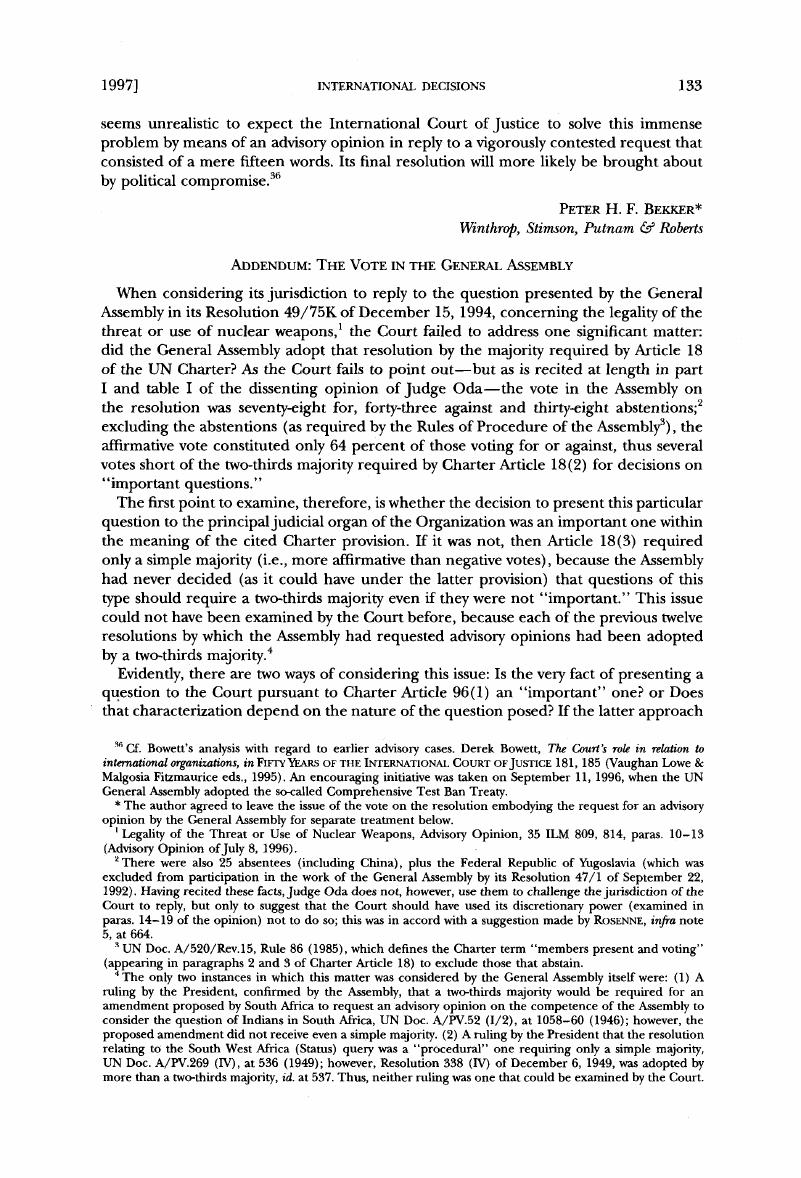No CrossRef data available.
Article contents
Addendum: the Vote in the General Assembly
Published online by Cambridge University Press: 27 February 2017
Abstract

- Type
- International Decisions
- Information
- Copyright
- Copyright © American Society of International Law 1997
References
* The author agreed to leave the issue of the vote on the resolution embodying the request for an advisory opinion by the General Assembly for separate treatment below.
1 Legality of the Threat or Use of Nuclear Weapons, Advisory Opinion, 35 ILM 809, 814, paras. 10–13 (Advisory Opinion of July 8, 1996).
2 There were also 25 absentees (including China), plus the Federal Republic of Yugoslavia (which was excluded from participation in the work of the General Assembly by its Resolution 47/1 of September 22, 1992). Having recited these facts, Judge Oda does not, however, use them to challenge the jurisdiction of the Court to reply, but only to suggest that the Court should have used its discretionary power (examined in paras. 14–19 of the opinion) not to do so; this was in accord with a suggestion made by Rosenne, infra note 5, at 664.
3 UN Doc. A/520/Rev.l5, Rule 86 (1985), which defines the Charter term “members present and voting” (appearing in paragraphs 2 and 3 of Charter Article 18) to exclude those that abstain.
4 The only two instances in which this matter was considered by the General Assembly itself were: (1) A ruling by the President, confirmed by the Assembly, that a two-thirds majority would be required for an amendment proposed by South Africa to request an advisory opinion on the competence of the Assembly to consider the question of Indians in South Africa, UN Doc. A/PV.52 (1/2), at 1058–60 (1946); however, the proposed amendment did not receive even a simple majority. (2) A ruling by the President that the resolution relating to the South West Africa (Status) query was a “procedural” one requiring only a simple majority, UN Doc. A/PV.269 (TV), at 536 (1949); however, Resolution 338 (IV) of December 6, 1949, was adopted by more than a two-thirds majority, id. at 537. Thus, neither ruling was one that could be examined by the Court.
5 Blaine Sloan favors this approach in Advisory Jurisdiction of the International Court of Justice, 38 Cal. L. Rev. 830, 836–38 (1950), as does Shabtai Rosenne, The Law and Practice of the International Court 663–64 (2d rev. ed. 1985). Other commentators have examined the sparse practice and remained neutral: Kenneth James Keith, The Extent of the Advisory Jurisdiction of the International Court of Justice 44–47 (1971); Paul C. Szasz, Enhancing the Advisory Competence of the World Court, in 2 The Future of the International Court of Justice 499, 504–05 (Leo Gross ed., 1976); Hermann Mosler, analysis of Charter Article 96, in The Charter of the United Nations: A Commentary 1011, para. 12 (Bruno Simma ed., 1994).
6 See Rüdiger Woifrum, analysis of Charter Article 18, in The Charter of the United Nations, supra note 5, at 320, para. 10, and 322–23, para. 19, and the other commentators there cited.
7 UN Doc. A/49/PV.90, at 35–36 (1994).
8 Legal Consequences for States of the Continued Presence of South Africa in Namibia (South West Africa) notwithstanding Security Council resolution 276 (1970), 1971 ICJ Rep. 16, 21–23, paras. 20–26 (June 21).




